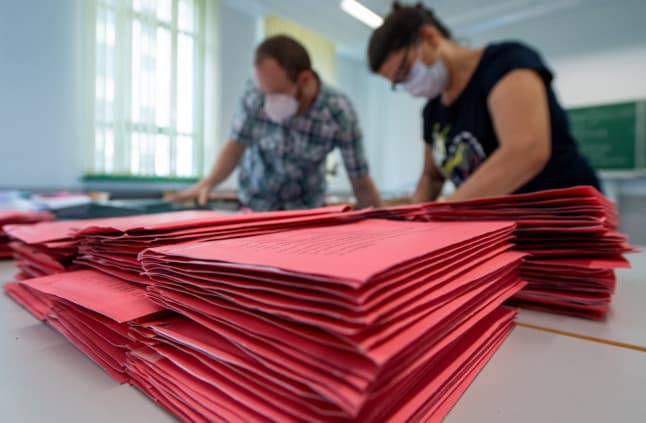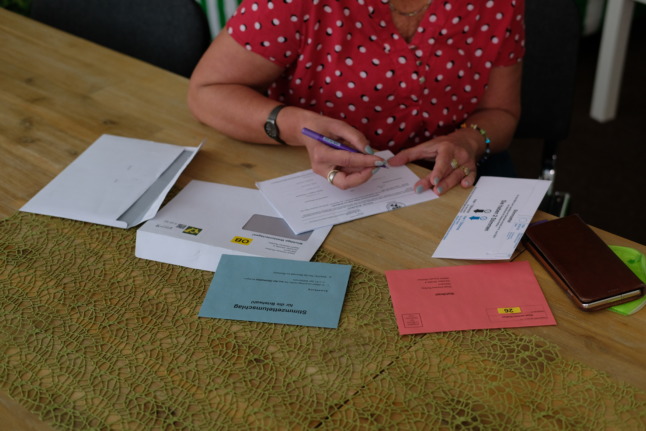EXPLAINED: How to cast a postal vote in the German elections

The list of eligible voters in the German elections was finalised on Sunday, meaning postal ballots could start to be sent out on Monday. Here's how to cast an absentee ballot in the September elections.
In the past, German voters needed a specific reason - such as being out of the country - to vote by post, and postal voting rates have historically been low. Though the rules on postal voting were relaxed in 2013, only 29 percent of eligible voters cast an absentee ballot in the 2017 elections.
However, in light of the rising infection rates and ongoing Covid pandemic, the number of postal votes could rise significantly in 2021. If you're thinking of casting your ballot at the nearest post box rather than a polling station, here's what you need to know beforehand.
Who can vote by absentee ballot?
In principle, all eligible voters, "without the existence of a special reason," can vote by post. In 2013, the Federal Constitutional Court ruled in favour of a new law to allow all eligible voters to cast an absentee ballot.
According to the court's judgement, allowing postal voting serves the goal of achieving the broadest possible voter participation and therefore complies with the principle of universal voting rights that is set out in the Basic Law.
In order to vote in the Bundestagswahl (the federal elections on September 26th), you must be over-18 and hold German citizenship.
READ ALSO: EXPLAINED: Who can vote in German elections
How do you get the documents?
Whatever you do, don't try to apply for them at the Federal Election Commissioner's office.
Instead, you can obtain the documents from the local authority at the address where you're registered. A form for applying for the ballot paper you need will be enclosed with the so-called 'election notification', which should reach eligible voters by the beginning of September.
If you're itching to cast your vote as soon as possible, however, you don't have to wait for it. The Federal Election Commissioner advises people to apply for a ballot paper "as early as possible" - and by 6pm on Friday, September 17th, at the very latest. You can do this by emailing your local Bezirksamt with your name, date of birth and address.
What do you have to keep in mind when filling out the form?
When you get your election notification, you should receive a ballot paper, your ballot, an information sheet and two ballot envelopes: one in blue, and one in red.
The information sheet explains how absentee voting works.

Make sure you sign and date your ballot after writing down your first and second preferences, or your vote may not be counted. Photo: picture alliance/dpa/dpa-Zentralbild | Sebastian Willnow
In short, you'll need to mark your first- and second-choice votes on the ballot paper in private. Fold the slip, put it in the blue envelope and seal it. Date and sign the ballot paper. Put the blue envelope plus the ballot paper in the red envelope, seal it and put it in the mailbox without a postage stamp - or take it to the place indicated on the envelope.
READ ALSO: How Germany’s new legion of foreign voters are gearing up for the election
Can I be sure that my vote will be received?
Yes, the red colour of the envelopes is designed to make them easily identifiable as postal ballots.
According to the Federal Election Commissioner, Deutsche Post has given a guarantee that ballot papers that are posted the day before the election will be delivered on the Sunday of the election. If it's not possible to post the red envelope in time, it can be handed in on election day at the location indicated on the envelope.
Do postal votes have a higher chance of being discounted in the election?
Definitely not. In fact, in the last federal election, 0.9 percent of first votes cast by mail were invalid - compared with 1.4 percent of those cast on election day. Of the second votes, the figure was as low as 0.5 percent (by mail) compared with 1.2 (by ballot box).
How many people vote by absentee ballot in the first place?
Since 1957, the proportion of absentee voters has risen from just under five percent to almost 29 percent in 2017. As mentioned above, this figure is set to rise yet again this year due to the ongoing pandemic.
Comments (6)
See Also
In the past, German voters needed a specific reason - such as being out of the country - to vote by post, and postal voting rates have historically been low. Though the rules on postal voting were relaxed in 2013, only 29 percent of eligible voters cast an absentee ballot in the 2017 elections.
However, in light of the rising infection rates and ongoing Covid pandemic, the number of postal votes could rise significantly in 2021. If you're thinking of casting your ballot at the nearest post box rather than a polling station, here's what you need to know beforehand.
Who can vote by absentee ballot?
In principle, all eligible voters, "without the existence of a special reason," can vote by post. In 2013, the Federal Constitutional Court ruled in favour of a new law to allow all eligible voters to cast an absentee ballot.
According to the court's judgement, allowing postal voting serves the goal of achieving the broadest possible voter participation and therefore complies with the principle of universal voting rights that is set out in the Basic Law.
In order to vote in the Bundestagswahl (the federal elections on September 26th), you must be over-18 and hold German citizenship.
READ ALSO: EXPLAINED: Who can vote in German elections
How do you get the documents?
Whatever you do, don't try to apply for them at the Federal Election Commissioner's office.
Instead, you can obtain the documents from the local authority at the address where you're registered. A form for applying for the ballot paper you need will be enclosed with the so-called 'election notification', which should reach eligible voters by the beginning of September.
If you're itching to cast your vote as soon as possible, however, you don't have to wait for it. The Federal Election Commissioner advises people to apply for a ballot paper "as early as possible" - and by 6pm on Friday, September 17th, at the very latest. You can do this by emailing your local Bezirksamt with your name, date of birth and address.
What do you have to keep in mind when filling out the form?
When you get your election notification, you should receive a ballot paper, your ballot, an information sheet and two ballot envelopes: one in blue, and one in red.
The information sheet explains how absentee voting works.

Make sure you sign and date your ballot after writing down your first and second preferences, or your vote may not be counted. Photo: picture alliance/dpa/dpa-Zentralbild | Sebastian Willnow
In short, you'll need to mark your first- and second-choice votes on the ballot paper in private. Fold the slip, put it in the blue envelope and seal it. Date and sign the ballot paper. Put the blue envelope plus the ballot paper in the red envelope, seal it and put it in the mailbox without a postage stamp - or take it to the place indicated on the envelope.
READ ALSO: How Germany’s new legion of foreign voters are gearing up for the election
Can I be sure that my vote will be received?
Yes, the red colour of the envelopes is designed to make them easily identifiable as postal ballots.
According to the Federal Election Commissioner, Deutsche Post has given a guarantee that ballot papers that are posted the day before the election will be delivered on the Sunday of the election. If it's not possible to post the red envelope in time, it can be handed in on election day at the location indicated on the envelope.
Do postal votes have a higher chance of being discounted in the election?
Definitely not. In fact, in the last federal election, 0.9 percent of first votes cast by mail were invalid - compared with 1.4 percent of those cast on election day. Of the second votes, the figure was as low as 0.5 percent (by mail) compared with 1.2 (by ballot box).
How many people vote by absentee ballot in the first place?
Since 1957, the proportion of absentee voters has risen from just under five percent to almost 29 percent in 2017. As mentioned above, this figure is set to rise yet again this year due to the ongoing pandemic.
Join the conversation in our comments section below. Share your own views and experience and if you have a question or suggestion for our journalists then email us at [email protected].
Please keep comments civil, constructive and on topic – and make sure to read our terms of use before getting involved.
Please log in here to leave a comment.